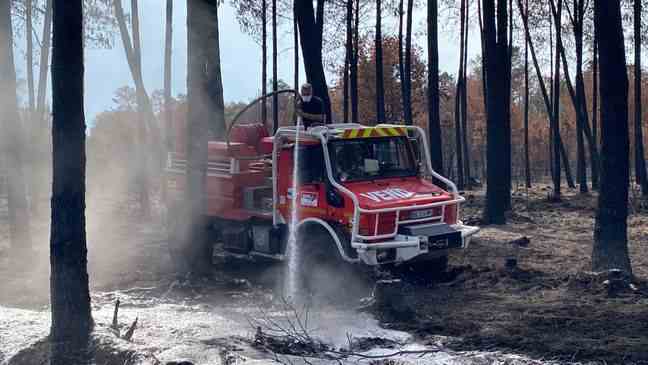The walls of flame in the heart of summer gave way to a carpet of ashes. Since the so-called Landiras fire, in Gironde, was declared fixed on August 14, then brought under control on August 25, the teams of firefighters, supported by Civil Security units supervising soldiers, have entered a new phase. , that of the treatment of forest edges and “hot spots” underground.
“This is the most thankless phase of the operation, and yet it is absolutely essential, because the Landiras fire is not completely extinguished, insists the commander of the Gironde firefighters, Matthieu Jomain. We still have 300 personnel, firefighters and soldiers, mobilized, even if we are gradually reducing this system, in view of the evolution of the situation and the climatic conditions, which are gradually becoming more favorable than what we experienced in heart of summer. »
The spectacle of desolation gives an idea of the power of fire
However, it is still 34°C in the air this Wednesday, August 31, when we accompany a team of firefighters to the heart of the forest between Hostens and Saint-Magne, ravaged during the resumption of the Landiras fire on August 9. Charred vegetation, the smell of burning, a layer of ash over several tens of centimeters on the ground… The working conditions of firefighters and integrated soldiers remain difficult, and the spectacle of desolation gives an idea of the power of the fire, which destroyed in all more than 20,000 hectares on this perimeter of Landiras, in July then in August.
“In some places, we have a layer on the ground of about 80 cm which has completely burned, then another layer of 80 cm of peat which remains incandescent, and sometimes lignite [minerai proche du charbon] which promotes the circulation of underground fire”, explains Chief Warrant Officer François, technical adviser to the training and intervention unit of Civil Security 7 in Brignoles (Var). It supervises integrated military sections, which were trained for two days and equipped by Civil Security and firefighters, to help deal with these hot spots.
Trucks take over from drones
It is this layer of incandescent peat that firefighters and soldiers relentlessly hunt down. Because it is from there that the fire can start again at any time. A mixture of roots and plant waste that has accumulated over time, peat is extremely present in the subsoil of this Landes de Gascogne forest. It is a highly flammable material that can spread fire underground.
To detect hot spots, all means are good, such as the drones of the Gironde firefighters, used for the first time on a large fire, since Wednesday. “The drones make it possible to fly over the burned areas and identify the hot spots, explains Captain Adrien. When they are spotted, we send trucks, with precise coordinates. »
Rake, backhoe and bulldozer to “open hot spots”
“We bring in the drone in the early morning, when the ground is still cool from the night, which makes it possible to better detect hot spots on the screen, adds Captain Isner. The idea is to give an aerial view, prioritize the first hot spots, then send ground personnel over them, in particular Civil Security units who will go to work in depth to find these hot spots. »
“We open hot spots with the help of rakes, or backhoes and bulldozers to cover larger areas, adds Chief Warrant Officer François, and then we drown out the fire using water tarpaulins or big tank trucks. Flooding the fire remains the safest technique, even if it consumes a lot of water since you can go up to 2,500 liters per minute”. It is at this price that all of these hot spots, measured up to 600°C by a thermal camera, can be permanently treated.

Waiting for the autumn rains
And if the first silviculturists have been authorized to enter the forest in recent days, to begin to recover the exploitable resource, the bulk of the work of cleaning and pruning can only really start when the forest is considered safe, this which is far from being the case today.
“The rains which fell recently remain relatively weak, and only the superficial layer was wet, they were not sufficiently penetrating to work these medium and deep layers to the heart,” explains Captain Isner. It is enough for the weather conditions to become unfavorable again for the surface layers to dry out again, and for a resurgent hot spot to trigger a new outbreak of fire. This is why we are really waiting for the autumn rains. An intervention device will remain based in Hostens until then.
